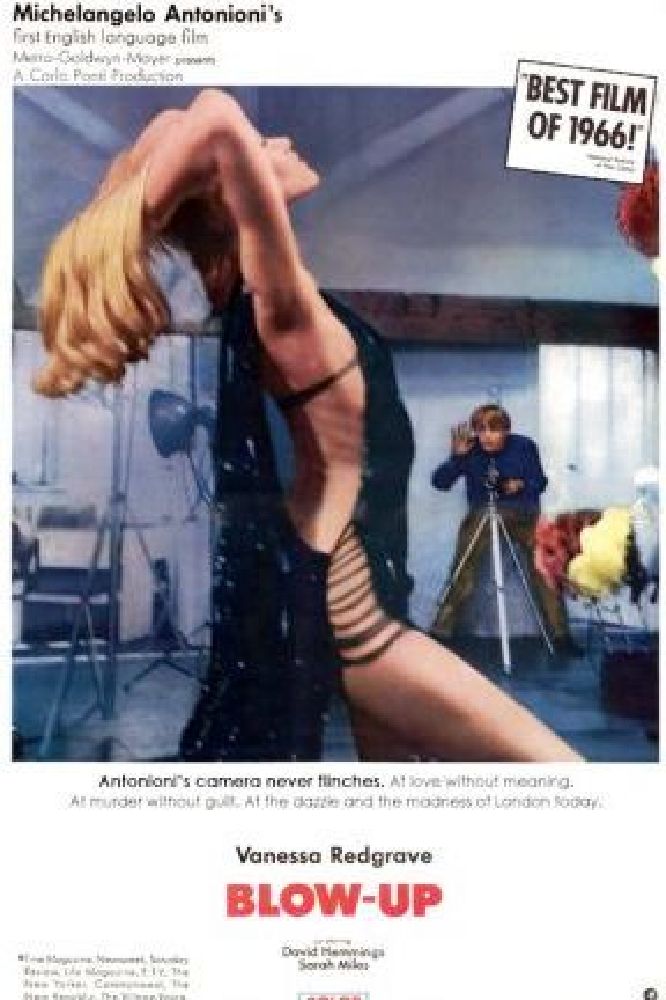
Blow-Up
The lively antics of a group of mimes begin this sixties film. Popular during this decade, street theater or happenings, drew the public audience into the spontaneous action of make believe, creating a different outcome with each performance.
It was a time when the youth rebelled against what they perceived to be their parents’ indulgent and stagnant day-to-day existence and when anything imagined seemed possible. Searching for meaning in life took the form of protests, social work, musical revolution, and drug and sexual experimentation. The youth struggled to discover which aspects of social culture needed to be discarded, embraced, or transformed.
The mimes and street protesters pop up throughout the film engaging the protagonist briefly each time. This successful fashion photographer (David Hemmings) is everyman. Despite his success, we find him restless. He’s tired of the repetitive assignment of photographing beautiful models and wants to get away. He leaves his models waiting while he spends time photographing downtrodden citizens and street scenes, searching for the authentic life and excitement.
During a visit with Bill, an artist friend, everyman listens to the artist’s interpretation of his pointillism-style paintings. Pointillist paintings are created by the application of small dots of color that, when seen from a distance, form a figure or object that appears as if it were frozen in time. Bill says, “They don’t mean anything when I do them, just a mess. Afterwards I find something to hang on to…It sorts itself out and adds up, like finding a clue in a detective story.”
Everyman wanders into a park and begins photographing the landscape. Soon his attention is diverted by a playfully affectionate couple. When the woman (Vanessa Redgrave) notices the intrusion she becomes upset and asks for the film. When everyman refuses, she runs off. He continues to take photos for a short while before leaving the park. The woman arrives at his studio demanding the film. The more she insists, the more everyman resists and the more his interest in the content of the photos is peaked.
Later, after developing the film, everyman spots a blurred image in a photo. Repeated enlargements of the photo reveals a disturbing image. He returns to the park to investigate. Excited by what he finds, he wants to share the moment with his friends. Bill’s girlfriend (Sarah Miles) tells him that the photo looks like the artist’s paintings. He goes searching for Ron, another friend.
Everyman takes a detour to stop at a concert. During the performance the amplifier malfunctions and the guitarist smashes his guitar against the stage. The audience storms the stage, but everyman grabs the broken neck of the guitar and runs into the street. He is pursued by the others for a while. Everyone wants the broken instrument until, quite suddenly, they don’t. Everyman also loses interest in the object and proceeds to a party to speak with Ron.
The partygoers have been tripping, partaking of mind-altering substances, and Ron has traveled to a place beyond conversation’s comprehension. Everyman finds an empty bed and sleeps until morning. When he returns to the park, the proof of his discovery has been removed. He has lost his chance to freeze the scene in time.
While leaving the park everyman encounters the mimes, who begin a mock tennis match. When the imaginary ball falls outside of the fence, everyman must decide how important the match and its participants have become to him and whether or not he will become involved. Notice the look on his face when he becomes aware of the result of his decision.
Blowup deals with an individual’s recognition and involvement in the changing conduct and values of society. It’s not always easy to know when a habit, career, relationship, goal, or social custom needs to be revitalized or put to rest. In troubling times the familiarity of ritual, acceptance of social norms, or escape to the drugs of substances and amusing pastimes can lull us into passivity.
But when the fit becomes uncomfortable or the status quo is in question, the need to step back and examine our individual and/or collective lives becomes apparent. Each person must decide when to take part in the necessary participation to advance the path that leads to a more just and life-affirming existence.
Michelangelo Antonioni was nominated for an Oscar in the categories of Best Director and Best Writing, Story and Screenplay. Unlike most art house films, this exceptional independent movie gained wide acceptance with the general public. Blowup reflected the personal struggles of individuals during the sixties but sends a timeless message to audiences today. Of course, this is just one interpretation of the film. You may find more compelling messages in this multifaceted story.
Tagged in Vanessa Redgrave

